Day 2 of a three day long weekend of Autumn Tours today. It was another lovely day, mostly bright and sunny, but with a blustery warm south wind which stopped it from feeling as hot as yesterday, even if it was 21C this afternoon. Not bad for late September!
A Wryneck had been reported at Beeston Bump recently, although seemingly rather elusive. As we were heading east today, we thought we would go and look for it even though, with clear skies overnight, there was a chance it might have moved on. When we arrived there was another problem – every path we took had someone out walking their dogs on a sunny Saturday morning! It quickly became clear that, if the Wryneck was still present, it would be hiding in the bottom of a bush rather than hopping about on one of the paths.
Still we had a quick walk round. The bushes were also rather quiet, being a bit exposed out here in the wind. We had also thought this might be a good spot to see some visible migration (or ‘vizmig’ for short), birds on migration moving along the coast. This certainly proved to be the case this morning and as we approached the cliffs we could see small parties of House Martins together with a few Swallows passing west along the clifftop. We stood for a while and could see more hirundines approaching from the east. Then a great cloud of House Martins passed by just below us. They stopped for a while to hawk for insects in the lee of the Bump and we counted at least 100 birds in the flock. Great stuff.
 House Martin – a flock of over 100 flew past us along the cliffs
House Martin – a flock of over 100 flew past us along the cliffs
We did a further quick circuit round via the pit without success and then decided to move on somewhere else. Back to the car, we made our way back along the coast to Salthouse and parked at Iron Road. The muddy pool on the west side of the the track has not been so productive for waders in the last couple of weeks, but is always worth a look just in case. There was nothing on there today but as we stopped at the gate we spotted a Wheatear on the near bank further along. Helpfully, as the cows came over towards us to investigate, they flushed the Wheatear which flew and landed right in front of us.
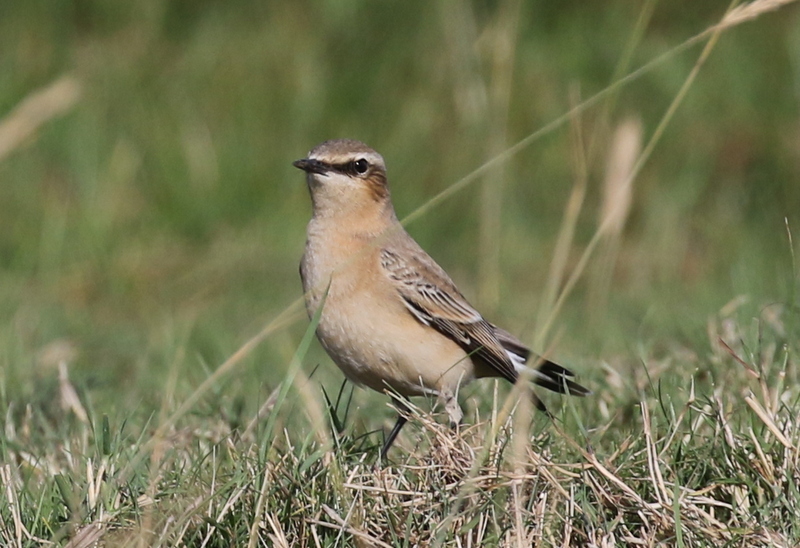 Wheatear – the first of several we saw today
Wheatear – the first of several we saw today
One of the group then spotted a second Wheatear further over. We walked along to the bridge but couldn’t see any more, but on the way back a Common Snipe flew past and landed out of view in the grass behind us. We were scanning for it, and watching a young Little Egret which had been pushed out of the ditch by another helpful cow, when a couple of very noisy dogs ran past and both the Snipe and the Little Egret promptly flew off.
On the walk round to Babcock Hide, we saw all the birds on Watling Water flush and fly off. With no sign of any raptors that side, it may have been some people who had just gone into the hide. We did see a Common Buzzard but it was circling up over Walsey Hills initially before it then drifted right over the path after everything had flown. It seemed to be taking advantage of the warm sunshine and hanging on the breeze. Just before we got to the hide, we flushed another two Wheatears from the edge of the reeds.
 Common Buzzard – drifted right overhead along Attenborough’s Walk
Common Buzzard – drifted right overhead along Attenborough’s Walk
As we sat in the hide, a few birds started to fly back in. A few duck returned – Gadwall, Teal and a single Shoveler – and the Little Grebes came back out from hiding in the reeds. Then three juvenile Ruff dropped in – or more precisely two male Ruff and a female Reeve. The females are noticeably smaller than the males and it was great to see them together for comparison. A single Black-tailed Godwit dropped in with them briefly before flying on west. Then the rest of the Ruff, a mixture of adults and juveniles, returned.
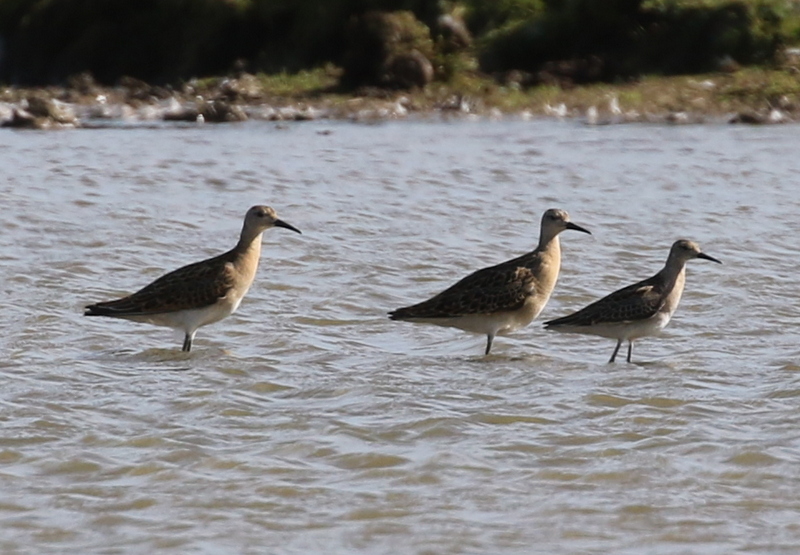 Ruff – two larger male Ruff and a smaller female Reeve
Ruff – two larger male Ruff and a smaller female Reeve
There is a good view east from Babcock Hide and scanning over the reeds beyond we could see a couple of Kestrels hovering in the distance. Then we picked up another falcon much further over, out beyond the shingle ridge. It gradually made its way closer and we could see that it was a Hobby, before it dropped down and disappeared behind the reeds.
On the walk back to the car, a Wheatear flew between the fence posts ahead of us, presumably one of the birds we had seen earlier. A Marsh Harrier flew in from the east, quartering low over the reeds. It was a juvenile but it had remarkably tatty wings, with a couple of big gaps. Hopefully they had just got broken rather than been shot at! A Canada Goose also flying in from Salthouse direction managed to flush a small flock of Black-tailed Godwits from one of the pools further along.
Round at the Visitor Centre, we opted for an early lunch in the September sunshine before exploring the rest of the reserve. On the walk out to the hides, there was no sign of the Whinchats reported earlier by the boardwalk, but it was very breezy round here now. A large flock of Golden Plover flew up from the scrapes and whirled round overhead.
 Golden Plover – a large flock flew up from the scrapes as we walked out
Golden Plover – a large flock flew up from the scrapes as we walked out
Pat’s Pool had a nice selection of waders on it again today. The highlight was a couple of Little Stints feeding out on the mud in the middle. They looked particularly tiny, even on their own, but we could see just how small they were when they were joined by three Dunlin. A larger group of Dunlin were feeding further over. There was still one Golden Plover left out on one of the islands, although it was doing a good job of hiding, blending in well with some tall dead grass. A single Ringed Plover was running around on the mud at first, before flying off. There were also a few Lapwing and a selection of Black-tailed Godwits and more Ruff.
There were a couple of small flocks of gulls here as usual, preening or sleeping. Mostly Black-headed Gulls, there were also several Lesser Black-backed Gulls with them. We didn’t see it fly in but, while we were watching the waders, a Caspian Gull appeared too. It was an immature bird, a 2nd winter. It immediately stood out, with its very white head, shawl of dark spots, long pointed face and long thin bill. Historically breeding around the Black and Caspian Seas, its range has been spreading west in Poland and eastern Germany, with dispersing birds increasingly found in UK. Caspian Gull is a great bird to see, still irregular in its occurrence here.
 Caspian Gull – this 2nd winter dropped in briefly
Caspian Gull – this 2nd winter dropped in briefly
We watched the Caspian Gull for a while and all had a good look at it in the scope, but when we took our eyes off it for a second it slipped away again as quietly as it had arrived. There were several other things to distract us. A juvenile Marsh Harrier circled over the reedbed before drifting right across the scrape, where it seemed to enjoy flushing the birds. Then it returned to the reedbed where it circled with a female for a while. We could see three more Marsh Harriers in the distance, beyond the East Bank. Several Bearded Tits called from the reeds in the ditch in front of the hide, but they remained tucked down out of view and out of the wind.
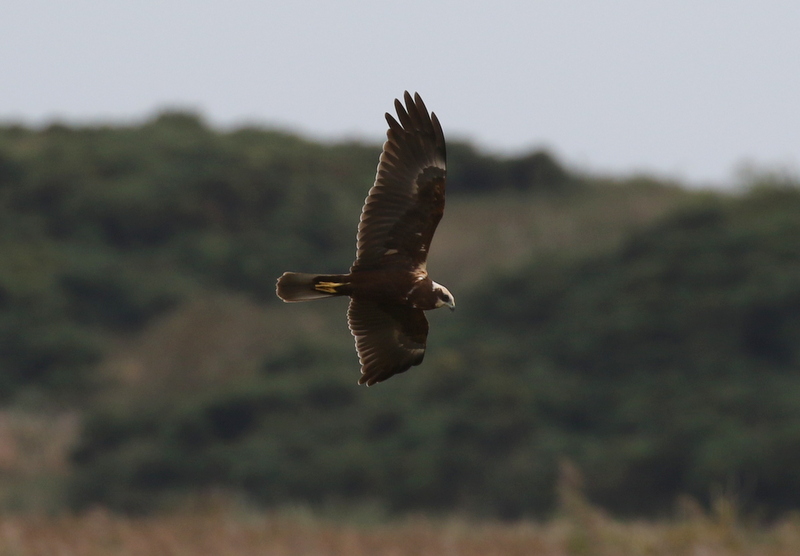 Marsh Harrier – two were over the reedbed this afternoon
Marsh Harrier – two were over the reedbed this afternoon
Works have been underway all week to reprofile Simmond’s Scrape, but the diggers were not working on the weekend. Several Curlew dropped in briefly and a couple of Grey Herons, but otherwise there did not appear to be much on there, possibly as a consequence of all the disruption. Still, we were glad we looked in on Dauke’s Hide because a Common Snipe was feeding in the grass right in front of the hide when we went it. We had stunning close-up views.
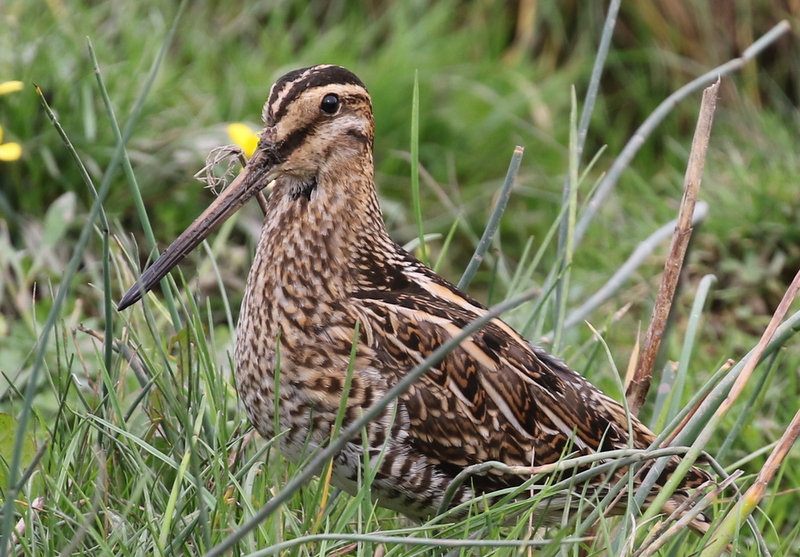 Common Snipe – feeding in the grass below the hide
Common Snipe – feeding in the grass below the hide
We watched the Common Snipe feeding for a while, creeping around in the grass and drilling its long bill repeatedly into the wet ground. It seemed perfectly happy in its chosen spot but a pair of Mute Swans were in the ditch nearby with their cygnet. Whether it really took offence to the Snipe or not, one of the Swans swam straight over to it and started to climb out towards it. The Snipe understandably reacted and ran up onto the top of the bank, standing there upright and alert. It was loathe to fly, presumably hoping to get back to its chosen feeding place, but the Swan continued up the bank and finally the Snipe flew.

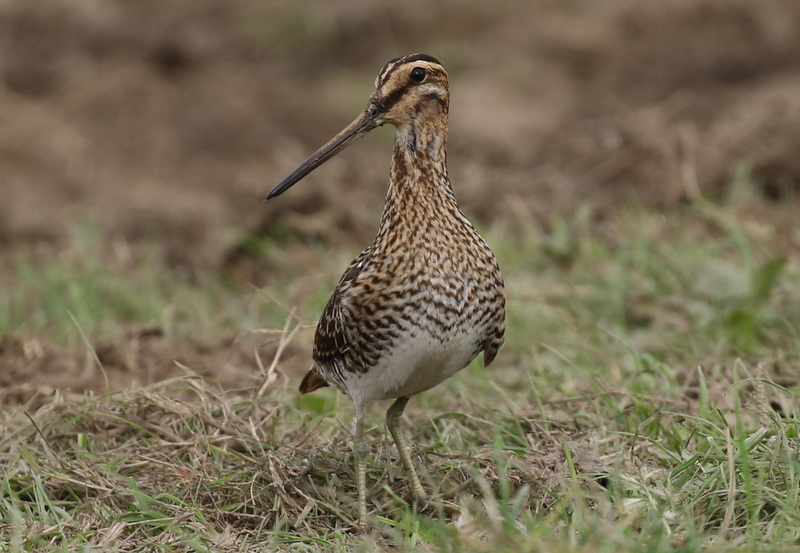 Common Snipe – flushed out onto the bank by a Mute Swan
Common Snipe – flushed out onto the bank by a Mute Swan
Several smaller birds found the banks around Simmond’s Scrape much to their liking, where the diggers had been working and scraped back the mud. There were lots of Pied Wagtails feeding on the ground and a couple of Meadow Pipits. Another Wheatear appeared, perched on one of the mounds of muddy earth left behind.
Back to the visitor centre and we drove round to the beach car park. A scan of the sea produced first a Guillemot flying past, then a Marsh Harrier flying in over the water. As well as many of our local breeding Marsh Harriers, many continental breeding harriers come here for the winter and this one was probably just arriving in from Europe. We picked up a few small flocks of ducks flying in too – seven Pintail appeared to go down towards North Scrape and a larger flock of Wigeon headed in towards the reserve. A couple of Brent Geese were just arriving in over the sea too. Migration in action!
The fence alongside the Eye Field can be very good for Whinchats so, with a couple reported earlier on the reserve, we thought this would be a good place to check out. Sure enough, despite the wind, we found three of them perched along the fence line on the walk out to North Scrape. We got a couple of them in the scope, a noticeably paler bird and a slightly darker one.
 Whinchat – 1 of 3 on the Eye Field fence this afternoon
Whinchat – 1 of 3 on the Eye Field fence this afternoon
The Whinchats flew on ahead of us as we walked out towards North Scrape, each time landing a little further on, always keeping their distance. Eventually they flew across to the fence out across the Eye Field.
We had hoped there might be a few waders on North Scrape, but that was not the case. There were a few ducks – particularly Shelducks – but no sign of the Pintail we had seen dropping down in this direction earlier. We enjoyed watching a couple of different Reed Buntings in the bushes behind the screen. First a rather streaky first winter appeared, before dropping down out of view. Then a few minutes another Reed Bunting flew in to the same bush – noticeably a different bird, with a darker face and a black bib partly obscured by pale fringing – a winter male.
As we made our way back, another Wheatear flew away from us across the shingle, landing on a large lump of concrete briefly, before flying away again flashing its white rump and tail base. A dark juvenile Gannet and four more Brent Geese flew past over the sea. We walked to the car listening to more House Martins calling as they passed overhead, finishing the day as we had started it.
















